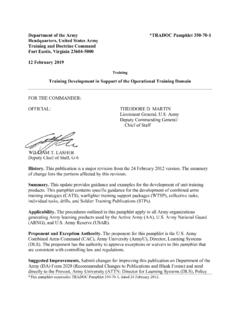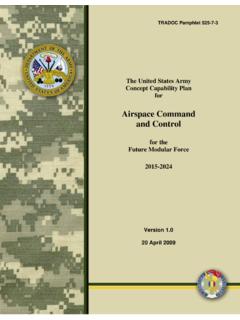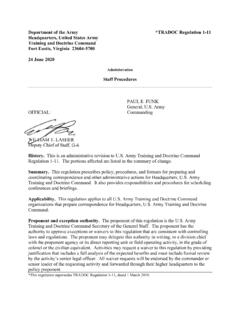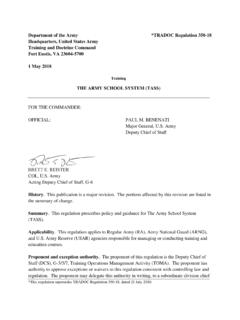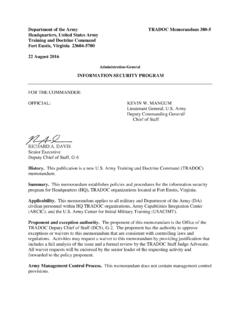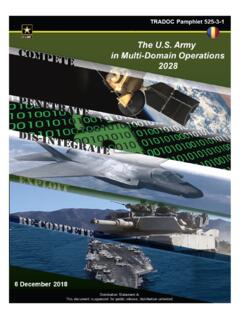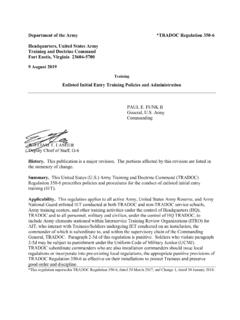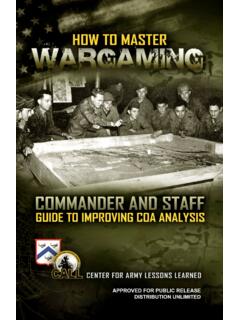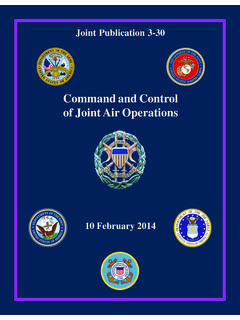Transcription of FOR THE COMMANDER: OFFICIAL - United States Army
1 Department of the Army TRADOC Pamphlet 350-70-14. Headquarters, United States Army Training and Doctrine Command Fort Eustis, Virginia 23604-5700. 27 March 2015. Training TRAINING AND EDUCATION DEVELOPMENT IN SUPPORT OF THE. INSTITUTIONAL DOMAIN. FOR THE commander : OFFICIAL : KEVIN W. MANGUM. Lieutenant General, USA. Deputy Commanding General/. Chief of staff RICHARD A. DAVIS. Senior Executive Deputy Chief of staff , G-6. History. This publication is a new Army Training and Doctrine Command (TRADOC). pamphlet. Summary. This pamphlet contains specific guidance for the development of courses and lessons, with supporting information on analyses, assessment, job aids and graphic training aids, training support packages, and training and education management. It provides guidance and examples for organizations that develop training and education products for the institutional training domain. This guidance and these examples use the process and concepts outlined in the Army Learning Model (ALM) and support the development of both task-based and education-based lessons.
2 Applicability. The procedures outlined in this pamphlet apply to all Army organizations generating Army learning products used by the Active Army (AA), Army National Guard (ARNG), Army Reserve (USAR), and Department of the Army (DA) Civilians. When there is a conflict between this pamphlet and TRADOC Pamphlet 350-70-7 in the development of learning products for Professional Military Education (PME), the following organizations will have TRADOC Pamphlet 350-70-7 take precedence: Army War College (AWC), Command and General staff College (CGSC), The Western Hemisphere Institute for Security Cooperation (WHINSEC), Warrant Officer Career College (WOCC), Army TRADOC Pamphlet 350-70-14. Sergeants Major Academy (USASMA), and The Defense Language Institute Foreign Language Center (DLIFLC also known as DLI). Proponent and exception authority. The proponent for this pamphlet is the Army Combined Arms Command (CAC), Training Management Directorate (TMD). The proponent has the authority to approve exceptions or waivers to this pamphlet that are consistent with controlling law and regulations.
3 Suggested Improvements. Users are invited to send comments and suggested improvements on DA Form 2028 (Recommended Changes to Publications and Blank Forms). directly to the commander , Combined Arms Center, Training Management Directorate (ATZL-CTD), Fort Leavenworth, KS 66027-2300; or electronically to Suggested improvements may also be submitted using DA Form 1045 (Army Ideas for Excellence Program (AIEP) Proposal). Distribution. This TRADOC pamphlet is available only on the TRADOC website Summary of Change TRADOC Pamphlet 350-70-14. Training and Education Development in Support of the Institutional Domain This pamphlet, dated 27 March 2015- o provides how to guidance for institutional domain training and education product development and management using the analysis, design, development, implementation, evaluation process (throughout). o implements the Army Learning Model using guidance and examples (throughout). o provides various product formats, checklists, and supporting information which support the developer in producing quality institutional training and education products (Appendices).
4 2. TRADOC Pamphlet 350-70-14. Contents Page Chapter 1 Introduction .. 9. 1-1. Purpose .. 9. 1-2. References .. 9. 1-3. Explanation of abbreviations and terms .. 9. 1-4. Scope .. 9. 1-5. Army learning policy and systems overview .. 9. 1-6. Institutional learning processes and products .. 9. 1-7. Army learning policy and systems and the analysis, design, development, implementation, evaluation (ADDIE) process .. 11. 1-8. Regulation and pamphlet 14. Chapter 2 Proponent Responsibilities and Support of Institutional Training and Education Products .. 15. 2-1. Introduction .. 15. 2-2. Training proponent information and identification (ID) 15. 2-3. Institutional training and education system .. 15. 2-4. Mandatory training in institutions .. 16. 2-5. Foreign disclosure (FD) restriction statements .. 16. 2-6. Copyright/proprietary materials/intellectual property .. 16. 2-7. Training development management .. 18. 2-8. Interfacing with other Army systems and processes .. 18. 2-9.
5 Application of the Army Learning Model (ALM) .. 18. Chapter 3 Operational Force Drivers of Generating Force Learning Products .. 20. 3-1. Introduction .. 20. 3-2. Needs analysis .. 20. 3-3. Learning product analysis process overview .. 28. 3-4. Mission analysis .. 28. 3-5. Safety and environmental protection .. 29. Chapter 4 Job 30. 4-1. Introduction to job analysis .. 30. 4-2. The job analysis process .. 30. 4-3. Individual task identification .. 32. 4-4. The total job task inventory .. 33. 4-5. Identifying potential critical tasks .. 34. 4-6. Critical task and site selection boards (CTSSB) .. 34. 4-7. The individual critical task list (ICTL) .. 35. 4-8. Individual task analysis .. 36. 4-9. The critical-individual task-to-lesson matrix .. 37. Chapter 5 Target Audience Analysis .. 37. 5-1. Introduction of target audience analysis .. 37. 5-2. Data collection planning .. 38. 5-3. Determine population size, location, and availability .. 38. 5-4. Develop data collection 39.
6 5-5. Data collection .. 41. 5-6. Data analysis procedure .. 42. 5-7. Review goals and 42. 3. TRADOC Pamphlet 350-70-14. 5-8. Determine reliability and validity of raw data .. 42. 5-9. Prepare analysis data .. 43. 5-10. Analyze data .. 43. 5-11. Interpret findings .. 45. 5-12. Target audience analysis for students in attendance .. 45. Chapter 6 46. 6-1. Introduction to courses .. 46. 6-2. Analysis .. 47. 6-3. Course design considerations .. 47. 6-4. Course design 49. 6-5. Course purpose and scope .. 50. 6-6. Course prerequisites .. 50. 6-7. Structure and sequence .. 51. 6-8. Course development .. 53. 6-9. Course management plan (CMP) .. 54. 6-10. Lesson design and development .. 54. 6-11. Individual student assessment plan (ISAP) .. 54. 6-12. Course map and course schedule .. 56. 6-13. Course length .. 59. 6-14. Write the student guide .. 59. 6-15. Resource requirements .. 60. 6-16. Developing an instructor/facilitator preparation guide .. 61. 6-17. Update/revise course design as needed.
7 62. 6-18. Obtain course and program of instruction (POI) approvals .. 62. 6-19. Quality control for courses (training product/material validation) .. 62. Chapter 7 Lessons and Lesson Plans .. 63. 7-1. Introduction to lessons and lesson 63. 7-2. Lesson analysis .. 64. 7-3. Lesson numbers and titling .. 64. 7-4. Lesson titles .. 65. 7-5. Lesson design for task-based lessons .. 66. 7-6. Developing and writing learning objectives .. 67. 7-7. Sequencing learning objectives .. 74. 7-8. Learning step activities (LSAs) .. 75. 7-9. Developing the 75. 7-10. Lesson plan development .. 77. 7-11. Modes of instructional delivery for lessons .. 78. 7-12. Instructional strategy and methods of instruction (MOIs) .. 78. 7-13. Instructor-to-student ratio and instructor requirements .. 81. 7-14. Lesson academic hours .. 82. 7-15. Media .. 83. 7-16. Media delivery .. 85. 7-17. Required resources .. 88. 7-18. Measuring learner performance: assessment .. 88. 7-19. Administrative 88. 7-20. Quality control for lesson plans.
8 89. 4. TRADOC Pamphlet 350-70-14. Chapter 8 Assessment .. 89. 8-1. Measuring learner performance: assessment .. 89. 8-2. Assessment methods .. 90. 8-3. Test types .. 91. 8-4. Student assessment design and development .. 91. 8-5. Check on learning questions .. 96. 8-6. Test development or test revision decision 96. 8-7. Test/test item analysis .. 98. 8-8. Assessing 21st Century Soldier Competencies .. 98. 8-9. Managing student assessments .. 99. 8-10. Assessment control .. 99. Chapter 9 Job Aids, Graphic Training Aids (GTAs), and Training Circulars (TCs) . 101. 9-1. Job aids and graphic training 101. 9-2. Job aid analysis .. 101. 9-3. Designing job aids .. 104. 9-4. Developing job aids .. 104. 9-5. Validation of job aids .. 104. 9-6. GTA design and development .. 105. 9-7. Quality control .. 106. 9-8. Training circulars .. 107. 9-9. Analyzing and designing training circulars .. 107. 9-10. Developing training circulars .. 108. 9-11. Quality control of training circulars.
9 108. Chapter 10 Training Support Packages (TSP) .. 108. 10-1. Introduction .. 108. 10-2. TSP numbering .. 108. 10-3. Designing TSPs .. 108. 10-4. Developing TSPs .. 108. 10-5. Quality control .. 110. Chapter 11 Managing Training and Education .. 110. 11-1. Introduction .. 110. 11-2. Proponent guidance for product management .. 112. 11-3. Automation of training and education products .. 113. 11-4. Quality control of training and education products .. 115. 11-5. Distribution of learning products .. 115. 11-6. Management of common core training and education .. 116. 11-7. Course management .. 116. 11-8. Course quality assurance and workload management .. 117. 11-9. Implementation management .. 117. 11-10. Instructor/facilitator and material preparation for implementation .. 120. 11-11. Evaluation during implementation .. 123. 11-12. Implementation closeout management .. 125. 11-13. Accreditation .. 127. Appendix A References .. 128. Appendix B Product and Supporting Product Checklists.
10 132. Appendix C Review Boards .. 137. 5. TRADOC Pamphlet 350-70-14. Appendix D Product and Supporting Product Examples .. 140. Appendix E ICTL to Lesson Crosswalk .. 144. Appendix F Learning Step Activity Sequencing .. 145. Appendix G Methods of Instruction .. 146. Glossary .. 152. Table List Page Table 3-1 Doctrine, organization, training, materiel, leadership and education, personnel, and facilities (DOTMLPF) problem example .. 25. Table 3-2 Learning product search procedure .. 27. Table 5-1 Sample size determination procedure .. 39. Table 5-2 Data analysis procedure .. 42. Table 5-3 Qualitative and quantitative data analysis .. 44. Table 6-1 Course prerequisite determination .. 51. Table 6-2 Course delivery modes .. 53. Table 6-3 General steps for writing an ISAP .. 55. Table 7-1 Types of learning objective standards .. 72. Table 7-2 Learning objective to lesson plan 74. Table 7-3 Learning step activity examples .. 75. Table 7-4 Identification of resource requirements for LSAs.
